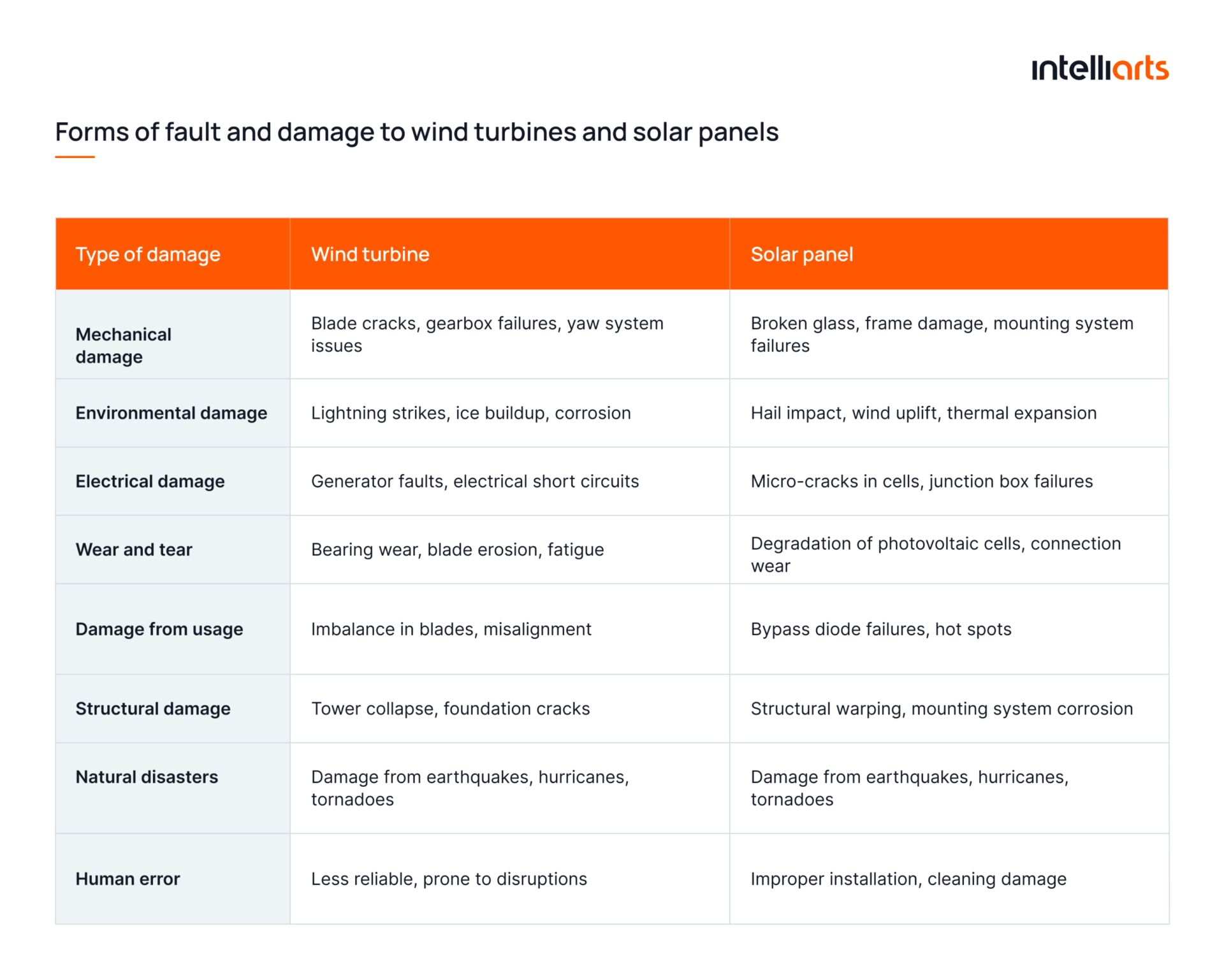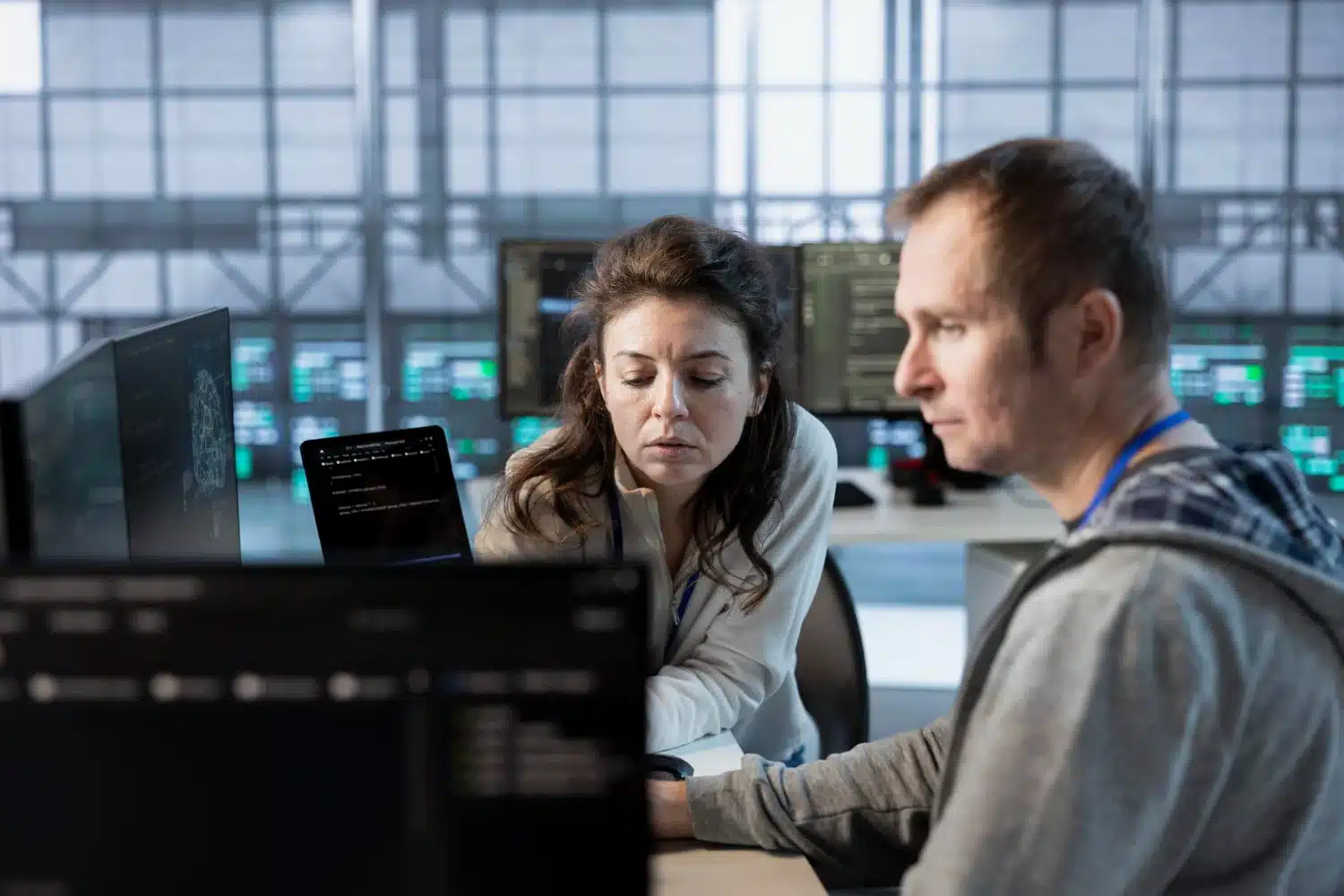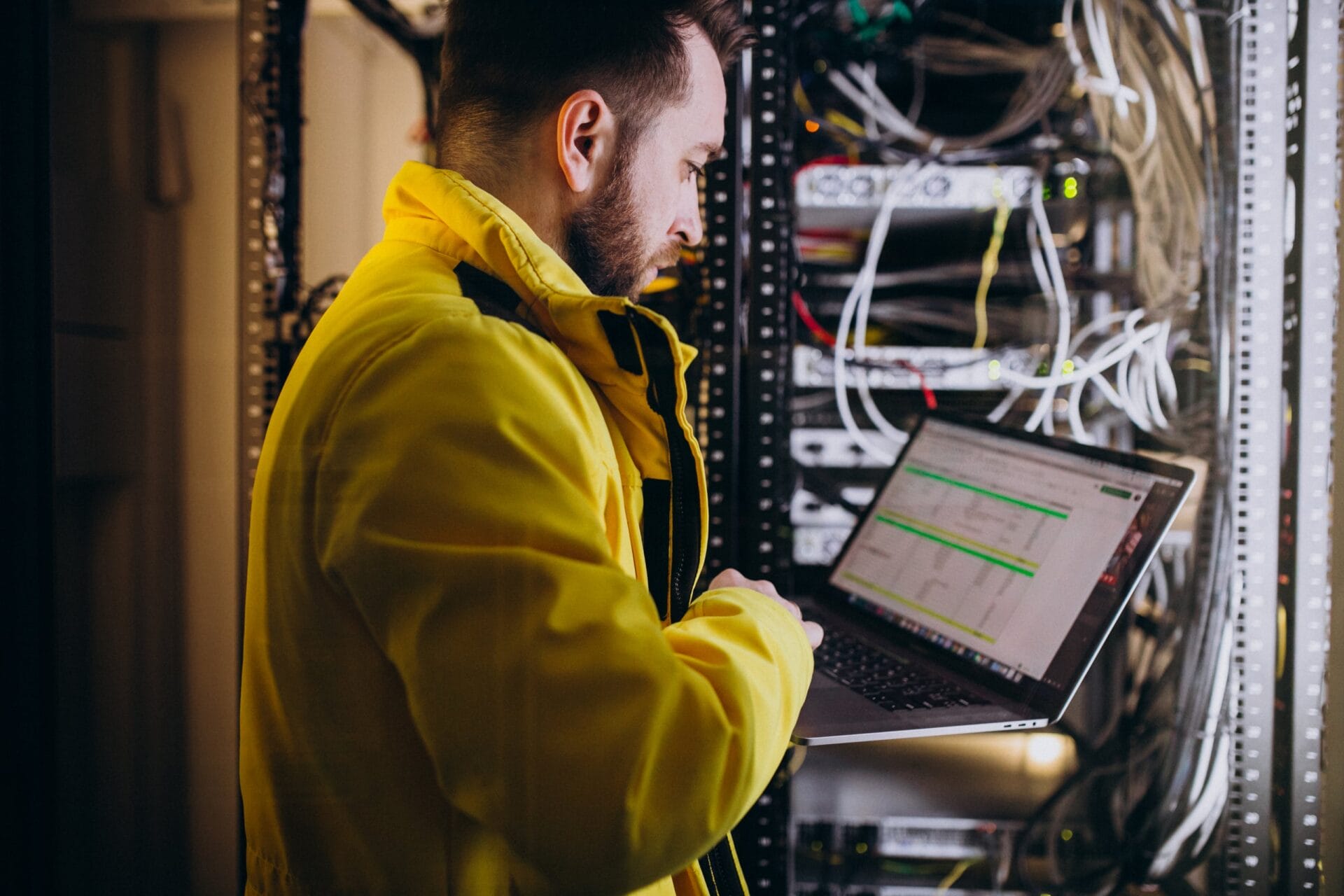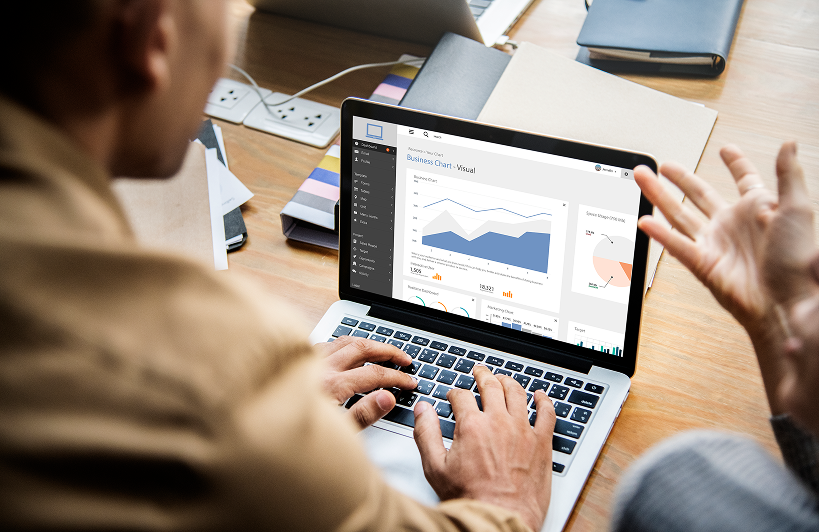More than 30% of all energy is already generated through renewable sources, including solar and wind. However, while trying to leverage renewable energy to the fullest extent, companies face engineering difficulties.
About 20% of solar panels suffer from some form of degradation or defect within the first five years of exploitation, with 90% of faults attributed to micro-cracks and hotspots. Similarly, 25% of wind turbines’ blades suffer from damage within the first 5 years. Fortunately, ML-based solutions are proven to be useful in solar panel fault detection, preventing downtimes. They can reduce inspection time by 50% and increase fault detection accuracy by 25% compared to conventional methods.
In this post, you’ll discover how ML can reshape damage detection in wind turbine blades and solar panels with computer vision. Besides, you’ll explore what Intelliarts, an AI development company, can offer as a software solution to damage detection challenges. Moreover, you’ll review the phase-by-phase procedure for implementing a fault and damage detection system in business.
Types of wind turbine and solar panel damage
You may discover all the main forms of fault and damage that can occur to wind turbines and solar panels in the infographic below:
Mechanical damage and wear and tear damage are some of the most widespread deterioration forms, while structural damage, environmental damage, and natural disasters are rare. Fault detection in solar panels and wind turbines is what serves prevention of downtimes in such critical equipment.
Conventional ways of fault and damage detection in wind turbines and solar panels
Typically, in such equipment as wind turbines and solar panels, technical maintenance is conducted by human workers. They utilize specialized equipment and methods of visual and manual inspection. Integrating IoT for solar energy projects can mitigate these maintenance and damage detection challenges, which are often associated with labor safety risks, costly and lengthy maintenance times, and limited capability to cover all energy units within reasonable times.
To further compare ML-based and manual ways of wind turbines and solar panel fault detection systems, let’s first check all conventional approaches in both types of energy units:
In wind turbines:
- Non-automated visual inspection: Manual checks for visible damage in turbines.
- Non-automated thermal imaging: Identifying overheating components.
- Vibration analysis: Monitoring for imbalance and wear.
- Acoustic emission monitoring: Detecting invisible damages by monitoring short bursts of acoustic energy in metal with cracks or imperfections.
- Oil analysis: Checking for wear particles and contamination.
- Load monitoring: Measuring stress on the turbine.
- Non-automated blade inspection via drone: Using drones for detailed blade inspections.
In solar panels:
- Non-automated visual inspection: Checking for cracks and physical damage in solar panels.
- Non-automated thermal imaging: Detecting hot spots and faulty cells.
- Electrical performance monitoring: Measuring electrical output for faults.
- EL (Electroluminescence) imaging: Detecting micro-cracks in cells.
- I-V curve tracing: Analyzing electrical performance.
- Non-automated drone inspection: Using drones for large-scale inspections.
- Cleaning and maintenance records: Tracking cleaning and maintenance activities.
As can be seen, there are both highly specialized forms of testing and less intricate, nevertheless labor-intensive inspection types. For complete insight, we need to understand well all the advantages and limitations of conventional damage and fault detection:
Pros of conventional ways of fault and damage detection are the following:
- Affordable and easy to implement
- Established and proven techniques
- Immediate results
Cons of sticking to conventional ways of fault and damage analysis only include:
- Reliance on labor resources
- Subjectivity
- Safety risks
- Not efficient with large volumes of equipment to be tested
You may be interested in exploring how AI changed renewable energy solutions in another blog post by Intelliarts.
Fault and damage detection and prevention in renewable energy with computer vision
As an alternative to the labor-intensive and tedious process of conventional fault and damage detection in the renewable energy sector, it can be proposed to use ML-based technologies. In particular, computer vision comes into great use here.
Computer vision is a field of artificial intelligence that enables computers to interpret and make decisions based on visual data from the world, such as images and videos.
You can discover extensive information about how computer vision works, and how computer vision can detect car damage in other our blog posts.
Here are ways of inspection that ML-based wind turbine blade damage detection and solar panel damage detection systems can offer:
- Automated visual inspection: Checks for visible damage in turbines.
- Automated thermal imaging: Identifying overheating components.
- Automated blade inspection via drone: Using drones for detailed blade inspections.
Fault detection technologies for solar panels and wind turbines have the potential to detect all forms of visual damage, from mechanical and electrical to operation, structural, wear and tear, etc.
The only issues are in the proper development of ML-based real-time damage detection systems and the implementation of the technology in actual business environments. Consequently, it brings us to the discussion of the strengths and limitations of such smart systems.
You may discover more about how AI and ML, in particular, computer vision, can be applied to solve renewable energy challenges in the video below:
Benefits and limitations of ML-based automated detection systems in renewable energy
The advantages of using ML solutions as a complementary way of fault and damage detection in wind turbines and solar panels are the following:
- Efficiency with large volumes of samples for analysis
- Consistent and unbiased analysis
- Operation 24/7 in case of real-time automated computer vision systems
- Complete safety for workers in case of drone or camera-based method of taking images for analysis
- Optimization of labor resource usage
At the same time, a few cons of AI-based fault detection in solar panels and wind turbines include:
- Relatively high initial investment costs
- High requirements for the technical expertise of engineers responsible for the implementation
- Complete automation and sometimes integration with other software and ML systems can be technically challenging
You may additionally be interested in exploring IoT in smart grid tech to find out more about other renewable energy solutions in another blog post by Intelliarts.
Intelliarts’ experience with fault and damage detection computer vision-based solutions
In this section, you’ll review two computer vision-based solutions for visible fault and damage detection, and test their demo versions.
Fault and damage detection in solar panels
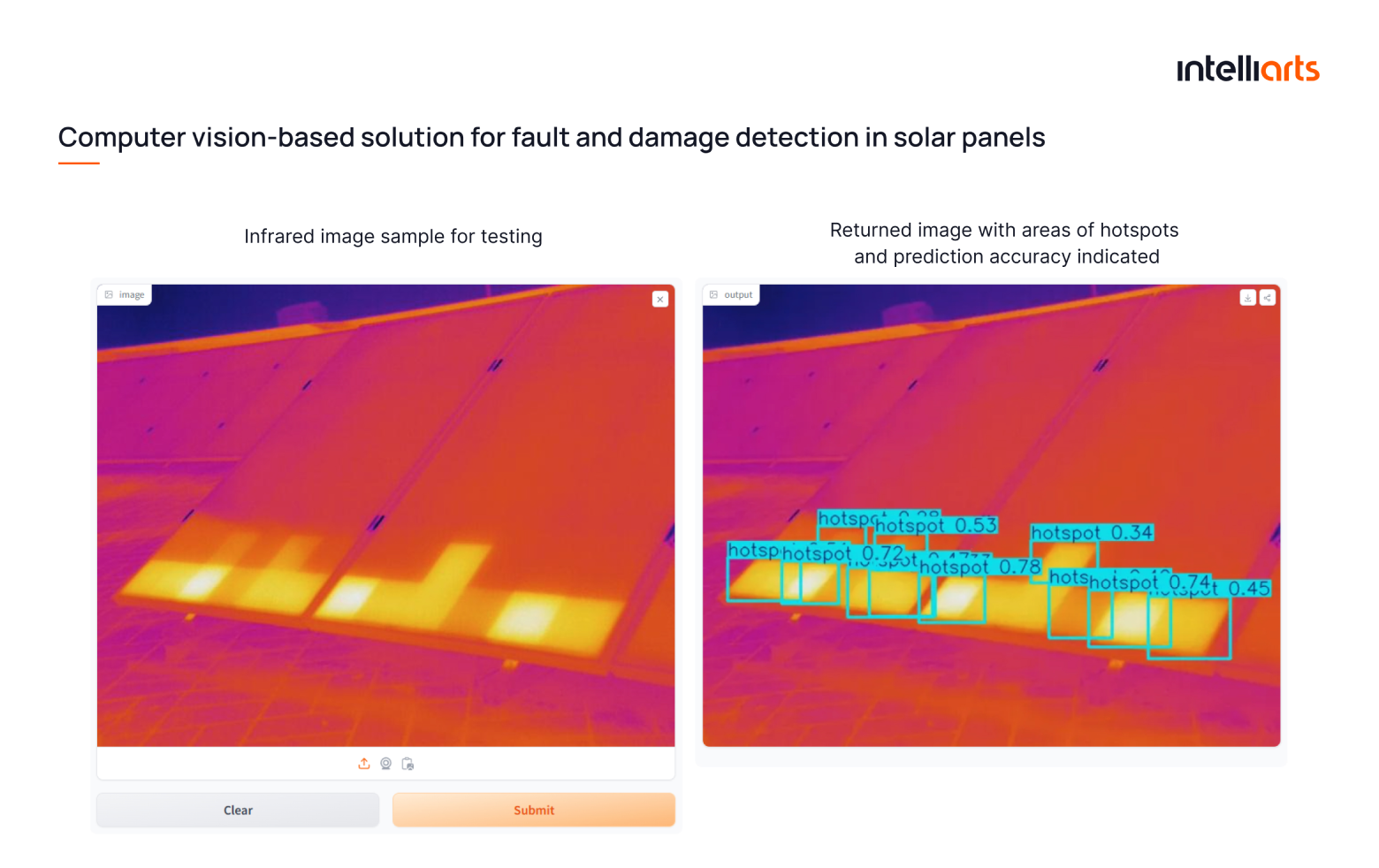
Recently, the ML team of Intelliarts prepared a demo of a computer-vision ML model intended to detect fault areas in solar panels. It is a part of our research on 2024 renewable energy challenges and fault detection technologies for solar panels and an attempt to contribute to maintaining a sustainable environment globally. With this ML solution, we intend to showcase to companies some innovative ways to solve sustainability, labor security, business operations, and other issues.
In the case of the solar panel damage detection demo by Intelliarts, the model works with infrared images of solar panels. Upon processing, the model returns images with damaged areas and approximate damage detection accuracy indicated. In this instance, damaged areas are outlined by a blue square.
In a similar way, an appropriately trained computer vision model can process regular solar panel images and wind turbine images for visible defects.
For this computer vision solution, we used a pre-trained model that is based on the YOLO image classification algorithm. We had a limited dataset, which consisted of 337 infrared images. That’s why we had to augment images to increase the number of instances in the dataset. So, given a more appropriate range of images for training a testing, a resulting solution can show even better results.
The prepared demo is rather a PoC than a finished product. As a potential business solution, it can be extended in numerous ways. For example, we can add:
- Native analytics capabilities or integration with external analytics systems.
- Detection of other types of faults in solar panels.
- Detection of visible faults and damages in wind turbines.
- Real-time automation.
- Integration with the software of cameras and drones.
- Real-time data exchange with a database connected to any external software.
- Continuous improvement of detection accuracy.
- Automated assessment of the probability of critical fault or combustion.
- Automated assessment of the reduction of energy generation because of fault and damage.
- Automated assessment of potential repair costs.
Fault and damage detection in wind turbines

The Intelliarts team created a model for fault and damage detection in wind turbines, which is similar to the model for fault and damage detection in solar panels.
In the case of the wind turbine fault and damage detection demo by Intelliarts, the model works with regular images of wind turbine blades. Upon processing, the model returns images with damaged areas and approximate damage detection accuracy indicated. Once again, damaged areas are outlined by a blue square.
Important note: Ways to extend this demo to a complete business-level solution are the same as for the solar panel damage detection demo and are listed in the previous section.
How to implement a fault and damage computer vision-based solution in business
The basic process of implementing a complex computer vision-enabled system boils down to the following key phases:
#1 Preparing the digital infrastructure for gathering data
Basically, you need to ensure that you systematically gather statistical and visual data for faults and damages in your wind turbines or solar panels as a part of your regular maintenance and repair procedures. This data will be used for training and testing an ML model later on.
#2 Developing a computer vision-based model
In this stage, you, or your hired ML team, choose an algorithm for the model and then train and test it. After that, they build a computer vision solution based on the finished model, adding the necessary features to it.
#3 Integration of the ready computer vision solutions into the infrastructure
Next, you need to make the finished solution a part of your existing system for gathering and processing data related to faults and damages in wind turbines or solar panels.
Naturally, you should have a repository of visual and statistical materials, a database with records for damages as well as maintenance and repair protocols. The goal is to enable the prepared computer vision system to work with such forms of data, both historical and supplied in real time. At the most basic level, you need to ensure that the computer vision model can:
- Process newly uploaded images in real-time, periodically in batches, or by request, depending on how you want to work with the solution.
- Yield results in a suitable format for you to process further.
- Access the database with reference images and all other complementary images to support fault and damage detection and enable the continuous improvement of the model.
#4 Integration of the ready computer vision solutions into the business operations
Finally, you need to make this computer vision solution an integral part of your business operations focused on technical maintenance and repair of wind turbines and solar panels. It includes training of the personnel, updating practices and procedures, acquisition of additional software instruments, implementation of other analytical systems, etc.
The end result is a well-integrated and highly usable computer vision system that is supplied with images taken by drones, cameras, or human workers. It processes images and yields results that are then used for analysis in connected analytical systems. Eventually, the business can obtain fault and damage detection reports with repair needs, repair pricing estimations, predictive maintenance forecasts, wear and tear patterns, and many more.
Needless to say, it’s hard to evaluate the end investment needed for such a large-scale project. The best way to obtain a general estimate is to request a quote from a trusted ML provider.
In case you are looking to implement automated fault and damage detection solutions, don’t hesitate to contact Intelliarts. We can offer IT technology audit of your existing infrastructure, provide technology consulting services, and offer end-to-end development and implementation.
Final take
Integrating ML-based computer vision systems is a solution to numerous solar panel and wind turbine maintenance challenges. Although the initial investment and technical expertise required may seem high, the long-term returns in terms of reliability, predictive maintenance, and operational continuity make it a worthwhile investment.
Intelliarts team of expert software engineers can offer the development of a computer vision model and its integration with your IT infrastructure end-to-end. We are Clutch global leader for 2023 and a company with more than 24 years of experience in the market, delivering software solutions to business challenges.
FAQ
1. What are the benefits of using your technology to detect defects in solar panels and wind turbine blades?
Our technology can provide real-time, automated defect detection for solar panels and wind turbine blades, reducing downtime, enhancing efficiency, and minimizing maintenance costs, ultimately leading to improved performance and reliability of renewable energy systems.
2. What kind of ROI can businesses expect from using your automated detection system?
While particular ROI depends on the business model and particular business scenario, our solution can offer significant improvement to the conventional fault and damage detection procedures at a relatively affordable cost. We absolutely expect ROI to be positive in all cases.
3. How quickly can your solution be integrated into our existing systems?
Depending on the ML model functionality your business needs, it may take 3-6 months to develop and implement our fault and damage detection solution. Deadlines largely depend on the data that will be available to us.




